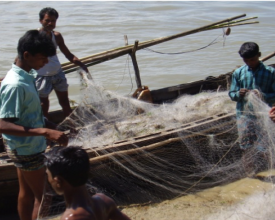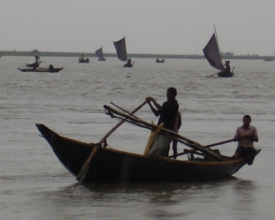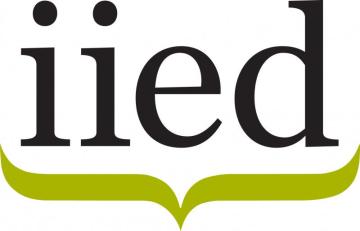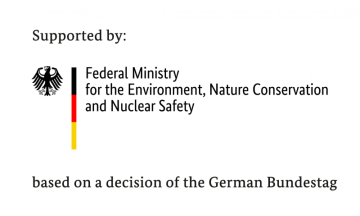
Incentive-based hilsa fisheries management
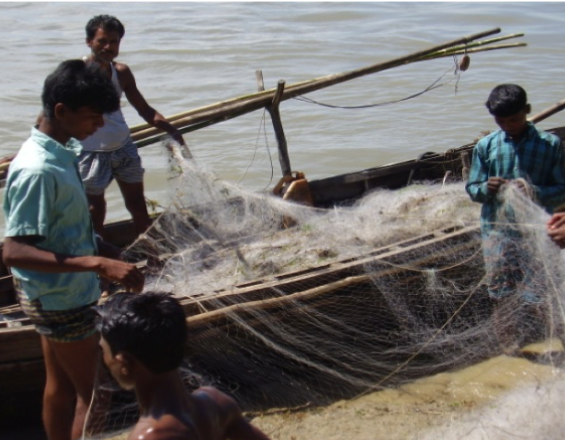
The solution Incentive-based Hilsa Fisheries Management comprises a suite of activities directly and indirectly related to the recovery of hilsa fish stocks in Bangladesh. The Bangladesh government coupled seasonal fishing bans and the creation of hilsa sanctuaries with food and income-based social support schemes; the aim was to maximise fish stock recovery, and minimise the burden placed on fishers by limiting their access to this culturally and economically important fish. Stocks of hilsa and other species were reported to have increased, and hilsa catch weight to have roughly doubled, since the management plan’s inception. Communities are supported when fishing isn’t possible, particularly through a food-based scheme. This solution is published as part of the project Ecosystem-based Adaptation; strengthening the evidence and informing policy, coordinated by IIED, IUCN and UN Environment WCMC.
Context
Challenges addressed
Hilsa fish has economic, social and cultural significance in Bangladesh. Hilsa production has been declining since the 1970s due to lack of proper management (overfishing) and climate-change related impacts, to the point where collapse of the entire stock is feared. Shifts in season, water salination, river bank erosion, increased temperatures, siltation and increased instances of extreme weather events all lead to breeding-ground and habitat degradation and changes in river morphology, reducing the chances of spawning success and influencing hilsa migration routes. Reduction in hilsa stock negatively impacts on Bangladesh’s poorest directly and indirectly, with most hilsa fishing being artisanal, and hilsa being the most affordable and preferred fish amongst the poor. Hilsa is nutritionally crucial to some 250 million Bengali people. It is also Bangladesh’s national fish, with huge cultural significance in Bengali culture.
Location
Process
Summary of the process
Nation-wide hilsa fishing bans (BBI) in Bangladesh provide time for uninterrupted spawning for this economically and culturally significant fish. To minimize the stress of the fishing bans on the poorest fishermen, who are often the most dependent on hilsa, a supporting compensation scheme (BBII) buffers the fishermen against the stress of livelihood loss, by providing either food grain or alternative income training to directly-affected fisher households.
BBIII, a proposed conservation trust fund, would support activities as detailed in BBI and BBII, helping to address some of the issues of enforcement and service provision as detailed below.
Building Blocks
Implementation of nationwide hilsa fishing bans
Each year there is a nationwide ban on catching, selling, transporting, marketing or possessing juvenile hilsa fish from 1st of November – 30thJune, 2-3 months complete ban on all kind of fishing including juvenile hilsa target species in 5 sanctuary areas (river stretches) in the major hilsa nursery ground and an additional short ban of 15 days in September/October at four hilsa spawning locations. This is to allow for protection of hilsa fish stock and uninterrupted spawning. Boat rallies are used to raise awareness and support for the fishing bans, as well as mass media, leaflets and posters explaining the importance of hilsa conservation.
Enabling factors
The central government must have the will and resources to be able to introduce a nationwide scheme such as this – in Bangladesh there exists a raft of acts providing the legal framework to support hilsa fishery management
- For the fishing ban to be effectively enforced, there must be good coordination between any central government bodies with jurisdiction over fisheries
- Good quality of ecological baseline data on spawning is an essential requirement for developing an appropriate fishing ban schedule
Lesson learned
Illegal juvenile hilsa fishing hasincreased since 2011; a major reason for this is the lack of resources available to support ban enforcement operations at night. Corruption (bribery) also hindered ban enforcement. Such issues damage the perceived legitimacy of the entire fisheries management scheme
- Decentralisation and devolvement of management and magistracy powers could potentially alleviate such issues
- Lack of equipment and supplies, such as boats and food, inhibit the capacity of staff to carry out enforcement activities even during the day
- There is a sense that some of the costs and benefits of the fisheries management plan are not distributed fairly: for example, it is perceived that fishers in bordering countries benefit from the increase in fish stock that result from fishing bans that impact only Bangladeshi fishers
Food and income-based compensation scheme for fishers
To support the overall hilsa fishery management plan, food grain compensation or training on alternative income-generation is provided to households directly impacted by hilsa fishing bans. Households receive either a monthly ration of rice throughout the long (four-month) fishing ban period, or they receive training and materials to help them diversify their income. If in receipt of the latter (referred to as AIGA – alternative income-generating activities), households are typically not entitled to rice compensation. Under AIGA, training offered includes livestock rearing, sewing, agriculture and net-mending.
Enabling factors
Both the food grain and the AIGA schemes are government schemes which were already established before the fisheries scheme, meaning these schemes could be readily linked to the fisheries scheme.
Lesson learned
- Because the food grain and AIGA schemes pre-date the national fishery management plan, neither were necessarily well-suited to addressing the complexities of fishing-based livelihoods
- Households receiving AIGA were generally not entitled to food grain, and uptake for the AIGA scheme was very low – in around 2014 only some 0.5% of households received this kind of support
- Ensuring participation from the outset of compensation scheme design will help to address this issue by ensuring local needs and wants are accounted for
- Many non-monetary benefits and costs, including opportunity costs, can be very difficult to account for and value
Hilsa Conservation Foundation
The Hilsa Conservation Foundation would act as a conservation trust fund (CTF). The CTF would provide some financial stability to Bangladesh’s overall hilsa fishery management programme, the efficacy of which has been impacted by lack of resources. A successful CTF would provide a source of finance that remains stable and reliable even in times of national economic or political shock, for supporting both ecological and social activities related to hilsa fishery management, such as BBI and BBII respectively.
Enabling factors
A multi-stakeholder workshop was held in 2015 for establishing the primary objectives of a hilsa CTF: these included sustainability of conservation schemes, wide coverage of fishers adversely impacted by hilsa fisheries management activities, equitable distribution of benefits from hilsa conservation, actions to promote restoration and conservation, and development of alternative livelihood activities for hilsa fishers. Participation from the outset is key to ensuring CTFs have context-specific, relevant and appropriate objectives.
Lesson learned
- To be successful, CTF’s must adhere to certain design criteria. This may include a detailed feasibility analysis, the establishment of a clear focus and conservation value, a participatory governance structure, and defined monitoring and evaluation standards
- There are a range of financing options available for CTFs – this could include fish export tax revenue, beneficiary fees, drawing on existing climate funds, drawing on a deposit into a fund with fair dividend rate, etc. Which mechanism is appropriate is context-dependent
- Think carefully about what kind of institutional mechanisms would ensure good governance in CTFs – e.g. a diverse board of governors (including high level government, NGO, fishing associations, the private sector) could help insulate a CTF from political agendas
Impacts
A range of groups benefited from ecological improvements and the resultant increased income-earning opportunities from fishing – not only fishers themselves, but also those involved in money-lending, wholesaling, retail, labour, and net- and boat-making. Particular benefit accrued to women, children and the elderly who, representing some of Bangladesh’s poorest people, stand to gain from the recovery of stocks of this favourite fish. Greater income allows more children to remain in education and buffers fishers against economic crisis, allowing for easier recovery from loans. Increased fish stock availability improves nutrition. Ecologically, not only hilsa but other fish species were reported to have increased in Bangladesh and possibly in India and Myanmar (although the highest perceived increase in catch is reported amongst those living close to fish sanctuary areas). Hilsa catch weight was also reported to have roughly doubled over 10 years since the introduction of the fishery management activities. Overall, the hilsa fishery management programme improved community resilience and adaptive capacity, reducing vulnerability to climate change and its associated challenges.
Beneficiaries
Hilsa-dependent fishing communities in Bangladesh; fishers of other fish and shellfish species.
